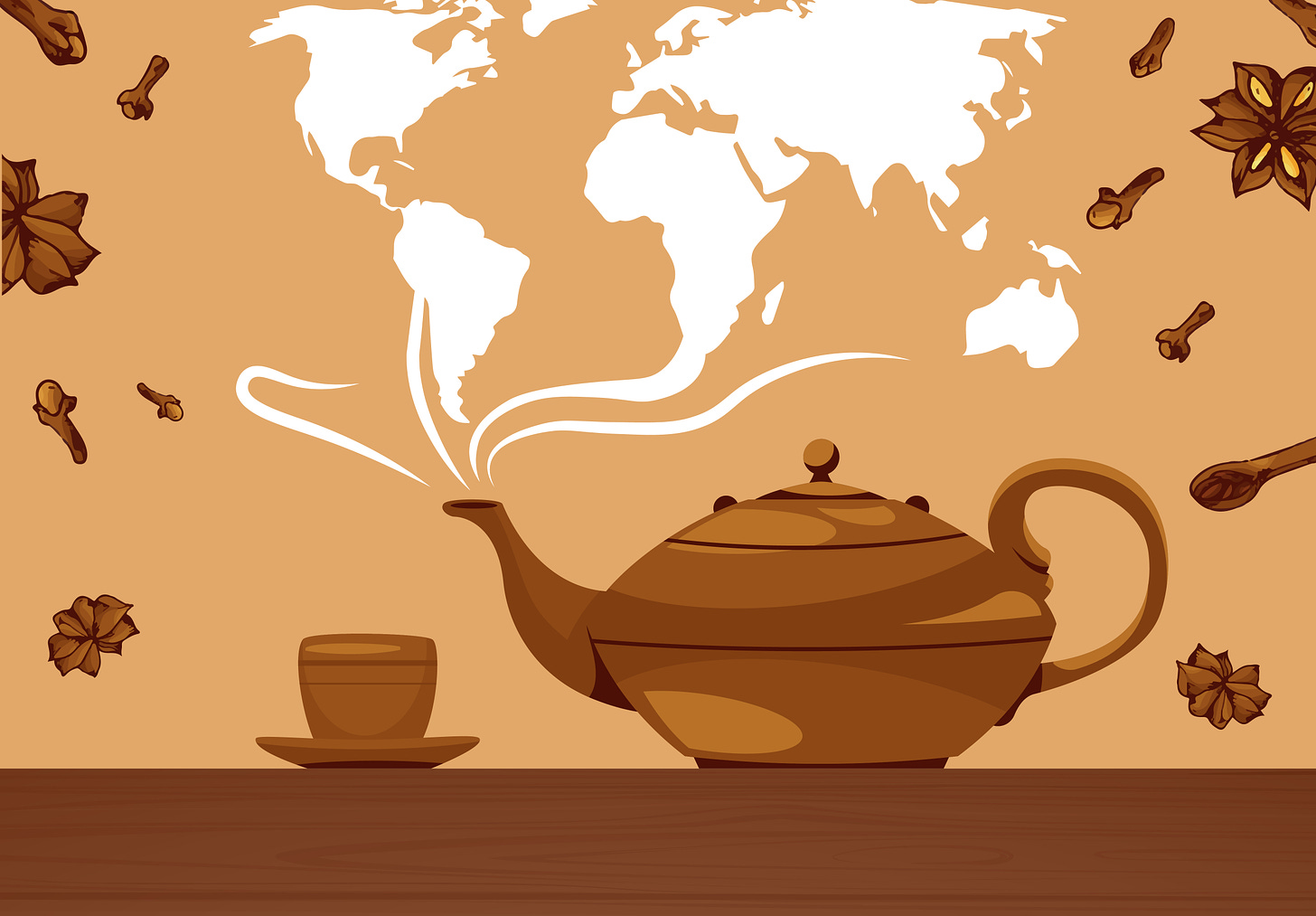Have you had your tea? This is a question we hear or ask at least once a day in many countries around the world. Have you not heard some people say that the day is lost without a good cup of tea? Tea is a beverage that is very much intertwined with our everyday lives. People sipping tea and chatting at teashops is a common sight in countries like India. From black tea to milk tea to green tea to tandoori tea to masala chai, there are many varieties of tea that are popular. Tea is a beverage that has been influential in the history of human civilization.
The relationship between humans and tea is older than the Egyptian pyramids. According to UK Tea & Infusions Association, tea was first cultivated in China about 6,000 years ago. However, in those days, tea was consumed by chewing the leaves instead of preparing a decoction.
Tea became the tea we see today only about 1,500 years ago. It had a long way to go before evolving into the delicious drink we consume today. Along with other ingredients, tea used to be added to boiled water and used as a remedy for various ailments. According to Britannica, tea became a daily drink only around the third century CE.
There is an interesting story about the origin of tea. It revolves around a legendary person called Shennong whom the Chinese admired and considered as their first ruler. The story goes like this. One day, Shennong was boiling water to drink while resting in his garden. Unbeknownst to him, a leaf flew and fell into the boiling water. When Shennong drank the water, he felt invigorated and noticed the difference in taste. According to Chinese legend, this was how tea was discovered.
An alternative version of this story is that Shennong unknowingly ate a poisonous plant while searching for edible grains and vegetables, and escaped death by chewing leaves from a tea plant nearby. On realising its medicinal value, Shennong became a strong advocate of tea. There is also a lesser-known story that credits Shennong’s servants with discovering tea.
Shunan Teng, founder and CEO of Tea Drunk says that the consumption of tea as a beverage is said to have originated in the provinces of Sichuan and Yunnan in China, where tea would grow naturally. From here, the tea’s status as a beverage spread through Buddhist monks to other parts of China as well as other Asian countries. The monks relied on tea to keep from falling asleep between long meditations.
The way tea was made and used in those days was very different from what it is today. The tea was dried, pressed, and stored in lumps, the size of a bowl. They would break these lumps into small pieces, add boiling water, ginger, salt, onion, and then drink it.
The transformation of tea into what we see today took place during the Tang Dynasty, which ruled China from 618 to 907 AD. Historians describe the Tang Dynasty as the golden age of Chinese culture. It was also during this period that people from all walks of life in China made tea a part of their daily lives. Green tea was the popular form of the drink at this time. It was only several centuries later that people began making black tea from dried tea leaves.
The popularity of tea spread from China to other Asian countries through trade routes, like the Silk Road. China had trade relations with Tibet, where they traded tea for war horses.
There is an interesting story about tea gaining popularity in Japan through Buddhist monks. Minamoto no Sanetomo was the third shogun of the Kamakura Shogunate military dynasty, which ruled Japan from the 11th century to the early 14th century. Once, Minamoto no Sanetomo’s condition became critical owing to alcoholism. Everyone thought he would die. However, Eisai, a Zen Buddhist priest, offered Sanetomo a cup of hot tea, following which Sanetomo recovered. During his reign, Sanetomo popularised tea throughout Japan. Even today, tea has an important place in Japanese society. There are special ceremonies in Japan to serve a form of tea called ‘matcha’.
During the reign of the Ming Dynasty in China in the 14th and 17th centuries, tea as a crop and beverage underwent a transformation to attain its present status. It was also during this period that China began trading tea with Western countries. In addition to silk and Chinese porcelain, tea also become a major trading commodity in China.
By the 1700s, the volume of tea that the East India Company had imported into England from China kept increasing exponentially with each passing year.
Tea was brought to Europe in 1610 by Dutch sailors who had visited China. The Dutch did not take to tea initially owing to its bitter taste and high price.
Tea made its way to England decades later. At that time, tea did not gain much traction among the English, who were coffee lovers. The good times of tea began in 1662, when Catherine of Braganza, the Princess of Portugal, married Charles II of England. Catherine, a great tea lover, asked for a cup of tea as soon as she set foot in England. The princess’s love of tea spread like wildfire across the country, and drinking tea became a trend in England. Taking advantage of this opportunity, the British East India Company ramped up the import of tea to England.
By the 1700s, the volume of tea that the East India Company had imported into England from China kept increasing exponentially with each passing year. Like China, the East India Company also becmae rich from the tea trade. China, the richest country in the world at the time, had no interest in British products. The Chinese only exchanged tea for silver. Over time, as silver became scarce, the East India Company planned to sell opium in China to break China’s monopoly on tea. Opium was the most potent drug of the time.
The easiest way to make opium in China was to cultivate it locally, but getting inside China was not easy. This was because of the Chinese method of trade known as the canton system, according to which foreigners were allowed to trade only through the port of Canton.
The British found an alternative to this by conquering the areas of India adjacent to China and cultivating opium there. In the Battle of Plassey in 1757, the East India Company captured Bengal and started cultivating opium there. Even though opium was illegal in China, the East India Company succeeded in making about one-third of the Chinese population addicted to opium by the middle of the 19th century. The book Sea of Poppies by Amitav Ghosh which was shortlisted for Manbooker in 2008 is based on these incidents.
In addition to the tea trade, the sale of opium in China led to an influx of wealth into the white man’s homeland. Using this wealth, Britain intensified its accoutrements and continued its invasion.
With the discovery of the secret of growing tea, the East India Company started cultivating tea in their colonies around the world.
The Chinese emperor decided to put an end Britain’s illicit trade. China seized about 1,400 tonnes of opium brought by Britain and dumped it in the sea. The war between the two countries later went down in history as the Opium War. In the war that took place from 1839 to 1842, Britain obliterated China. The situation in China began to worsen as the war brought shame, bankruptcy, and opium addiction. Civil unrest erupted. It is estimated that over 30 million people were killed in insurgencies.
Notwithstanding these setbacks, China still had a monopoly on tea production. Over time, the demand for tea increased. Though the East India Company made huge profits from importing tea from China, it sought to produce tea. Since the Chinese government had strictly forbade farmers from disclosing information about tea cultivation and its processing methods, the only way the East India Company could get information was by stealing it.
In 1848, the company sent Robert Fortune, a Scottish botanist, to China. Fortune donned Chinese attire, infiltrated the farming community, and learned the secrets of growing tea. When he returned, Fortune brought good-quality tea plants and a number of Chinese tea farmers with him.
With the discovery of the secret of growing tea, the East India Company started cultivating tea in their colonies around the world. Britain brought in slaves to work in the tea estates.
The global tea consumption in 2020 was 630 crore kilogrammes, which is estimated to go up to 744 crore kilogrammes by 2025. The next time you have a cup of tea, take a minute to reflect on the wars waged for these dry leaves!
Now put on your thinking hats and think about the following questions for a couple of minutes.
How would you describe the influence of Ming dynasty in the transformation of tea as a crop and beverage?
Can you think of how the popularity of tea spread from China to other Asian countries?
Can you think of the reasons why English East India Company encouraged the use of opium in China?
Write down your thoughts and discuss them with your students, children and your colleagues. Listen to their views and compare them with your own. As you listen to others, note how similar or different your views are to others’.
Thank you for listening. Subscribe to The Scando Review on thescandoreview.com.
Happy Teaching!













History wafting from a teacup